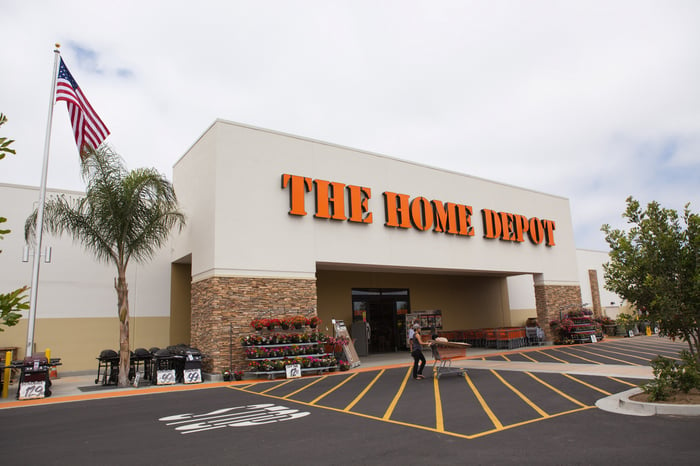Here's the answer to the headline's question: The Home Depot (HD -0.37%) is a great dividend stock. Of course, "great" is a relative term; there are various ways to measure greatness. However, after scrutinizing Home Depot's dividend from multiple angles, it's truly better than most.
Don't worry about the jargon now -- we'll define as we go. But Home Depot stock gives investors a good dividend yield, has a low payout ratio, and has opportunity for growth. That's why it's great and why dividend investors should give it a look.

Image source: The Home Depot.
High dividend yield
Dividends are what you get paid as a shareholder. Dividend yield, however, contextualizes the payment. Maybe two stocks both pay $1 per share annually -- the exact same dividend. But one stock trades at $50 per share while the other trades at $100 per share. The dividend yield of the former is 2%, while the yield of the latter is just 1%. All other things being equal, one would obviously want the dividend with the higher yield.
Home Depot stock currently has a dividend yield of 2.1%. To be clear, there are higher-yielding dividend stocks out there. For example, The Coca-Cola Company and Pfizer have yields exceeding 3% and 4% respectively. However, the current dividend yield average for the S&P 500 is just 1.7%. This means Home Depot's dividend yield is above average.
The true value of a high-yield dividend stock comes from reinvesting dividends over the long haul. Brokerages can set this up to happen automatically, and it can greatly increase your overall return. Just consider what would have happened if you had reinvested your Home Depot dividends over the last ten years.
Low payout ratio
A high dividend yield is meaningless if the dividend has a reasonable risk of being reduced. One way to assess a dividend's safety is by looking at the company's payout ratio. This metric measures how much a company is paying in dividends relative to how much it's earning. The higher the payout ratio, the higher a percentage of earnings are being paid out as dividends.
Home Depot's payout ratio is a very comfortable 52% right now. This gives it plenty of buffer if earnings fall unexpectedly. For example, many companies paused or canceled dividends this year because of the unanticipated COVID-19 pandemic. Notably, Home Depot was not one of those companies.
HD Payout Ratio data by YCharts
Over the last ten years, Home Depot management has kept the payout ratio mostly between 40% and 50%. As earnings rise, it increases the dividend proportionately. Because of this, investors can expect this dividend to continue being paid and even go up over time, as long as the company continues to grow earnings.
Superior earnings growth
Home Depot has been annually raising its dividend by a double-digit percentage for a decade. In February the dividend was raised 10% to $1.50 per share per quarter, more than double what the company was paying out in 2016. If it can continue at this pace, the dividend could double yet again in the next seven years.
In order to support dividend growth, Home Depot needs to continue growing earnings. The company has done this with ease over the last ten years.
HD EPS Diluted (TTM) data by YCharts
Earnings growth hasn't been a problem for Home Depot in 2020 either. Perhaps one of the surprising developments from the coronavirus was the growth of home-improvement retail. Most commerce was hurt with people stuck at home. But according to data from the U.S. Census Bureau, sales in the building material, garden, and supplies category were up 11.4% year over year during the first eight months of 2020. This trails only e-commerce and grocery-retail growth.
As the top dog in the home-improvement space, Home Depot was a primary beneficiary of the consumer-behavior shift. Its sales were up 16% year over year through the first two quarters. Diluted earnings per share (EPS) increased 12.5% over that span.
However, growth in 2020 presents a revenue headwind heading into 2021. It's possible some future sales were pulled forward; people had federal stimulus money and free time to knock projects off to-do lists. This could mean people are up to date with home repairs and will consequently spend less in coming quarters.
That said, Home Depot could have an earnings tailwind going into next year. The company has paid out $1.3 billion so far in 2020 in COVID-19-related labor expenses. Therefore, it's possible its EPS could climb as one-time coronavirus costs fall, even if sales fall slightly in 2021.
Given its rich dividend history and compelling metrics, Home Depot stock should be high on dividend investors' lists.








